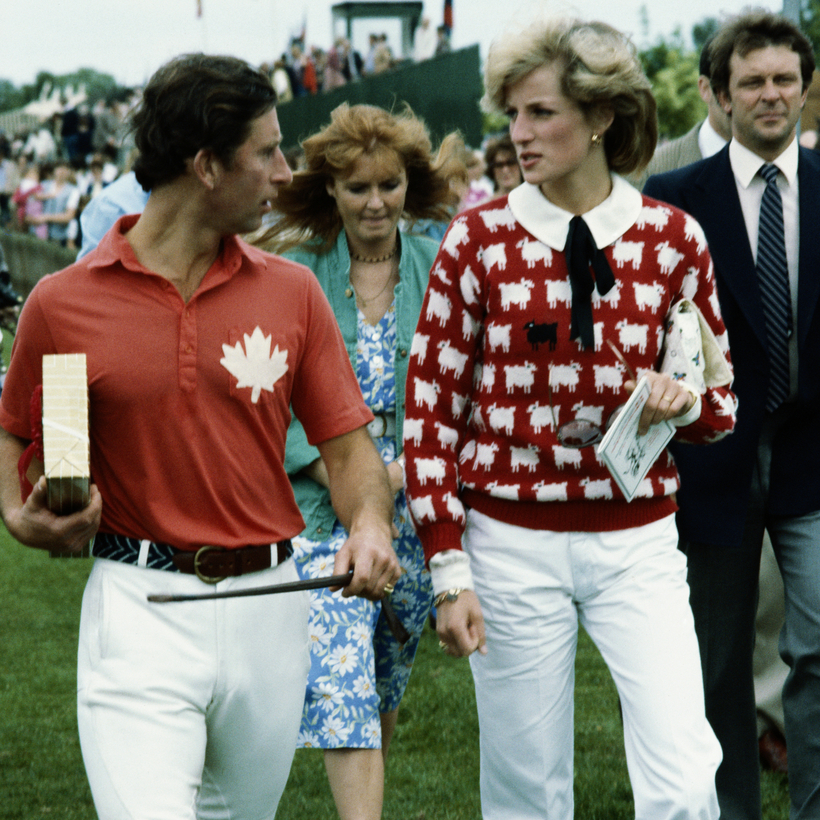There they were. In London’s trendy Notting Hill Gate the other day.
Posters with the identical red sheep jersey—rows of white sheep, interrupted by one lone black sheep—that Princess Diana used to wear to polo matches over a frilly piecrust collar just as she was establishing herself as the Super-Sloane who would be Queen.
It was the jersey that defined an era (the Victoria and Albert Museum snapped one up for its permanent collection in 1983), and now it is back, this time as a collaboration between the original designers (Warm & Wonderful) and the preppy American brand Rowing Blazers.

It’s been 40 years since That Jersey, and since Ann Barr and Peter York wrote their best-seller, The Official Sloane Ranger Handbook. It shared the inside secrets of the English subset of “Carolines and Henrys”—boarding-schooled, country-housed animal-lovers, the epicenter of whose universe was Sloane Square in Chelsea—and it is still on trend today.
The book codified everything: from their silver, engraved christening mugs and first loves (nanny, of course) through school, university, cookery, secretarial school/Sandhurst, their starter jobs in estate agency, law, auction houses, and to marriage, children, and even last rites. (Sloanes are allowed to cry only when the dog dies, not when Daddy does.)
“Furniture Must Look Old”
Like everyone else (in the Sloane sense of “everyone one knows or has heard of”), I had a copy, and can even remember the Kipling pastiche that opened this must-read of the 80s:
If you can fill the unforgiving minute
With sixty seconds’ worth of jolly fun …
Yes, it may be four decades since the book defined the tribe whose choice of jacket at a point-to-point or game fair was Husky, Puffa, or Barbour; whose choice of wheels was a Land Rover or Range Rover; and when it came to pets, whose choice was anything as long as it was a black Lab. It may be difficult to lay your hands on a copy (they are listed for thousands on Amazon and eBay; I had to borrow York’s to write this story), but here’s the thing.
Just as preppy will never go out of style in the U.S., thanks to white clapboard, “cottages” on the ocean, Maine, sailing, plaid, and battered station wagons (thanks, Ralph Lauren), here, the Sloane and all the Sloane stands for has never gone away or out of style, either.
The Sloane is a hardy perennial in the border of the English country garden, which is why the 2020 iteration of the sheep jersey in “Diana red,” first seen in 1980, retails for $295 online.

As the handbook’s subtitle, “The First Guide to What Really Matters in Life,” suggests, the Sloane was and is beyond fashion. Like Stonehenge, Wimbledon, or the royal family (love and respect for the Windsors is the institutional underwiring in every majestic Sloane bosom), the Sloane has, in almost every way, stood the test of time.
Take interior décor.
In a Financial Times piece marking his book’s anniversary, York revealed he sent the old list of 20 Sloane decorating dos and don’ts, such as “There Must Be a Fireplace” and “Furniture Must Look Old,” to the architect Ben Pentreath.
Pentreath flashed back a capitalized message:
NOT ONE RULE NEEDS TO CHANGE.
Apart from the stricture “There Should Be Embroidery About,” I agree, and I would go further and apply Ben’s verdict to all things Sloane.
The sensible names (mostly beginning with F and ending with A, like Fenella and Fiona) haven’t changed. Sloane professions haven’t changed (for Carolines, publishing, catering, jewelry, Sotheby’s or Christie’s, the royal households; for Henrys, the City, estate management, something vague in finance). The Sloane universities are still Durham, Exeter, or Edinburgh.

Sloanes still never give dinner parties on Friday nights, because “everyone” is leaving London for “straightforward shooting weekends” (in Prince Andrew’s phrase) or country-house parties.
The London hub pubs are still the Admiral Codrington, also known as “the Cod,” in Chelsea; the Churchill Arms in Kensington; and the White Horse in Fulham, also known as “the Sloaney Pony.”
Reduced Circumstances
What has changed, though, is where the Sloanes can afford to live in town and country, and this is big.
This is because, alas, the defining characteristic of the Sloane is “old money,” which means “almost no money” compared to the bottomlessly wealthy plutocrats and kleptocrats who have invaded their island.
So Sloanes still proudly drive their battered Defenders and wear ancient shooting tweeds that look as if they have been plucked from a compost heap in a boot room. They don’t mind that the parental “units” had to save to send them to “school” (Sloane code for Eton), and they go skiing only every other year.
What they do mind, though, is being forced out of their London pride lands and not being able to afford to keep or buy the sort of country pile you see selling for many millions in the glossy opening pages of property-porn mag Country Life.
Since the big bang—well, ever since London became the world capital of new and dirty money—Sloanes have been flung out centrifugally from Belgravia, Knightsbridge, Chelsea—even from Fulham—by the tech moguls, oligarchs, and Chinese and Indian billionaires to outer areas such as Battersea, Queen’s Park, Wandsworth, and Ravenscourt Park.
The defining characteristic of the Sloane is “old money,” which means “almost no money” compared to the bottomlessly wealthy plutocrats and kleptocrats who have invaded their island.
It is a humiliation to be bravely borne, but not for long.
One of the silver linings of the coronavirus was how it saved the bacon of many a suburban Sloane. “The pandemic justified being able to live in country full-time and not have to maintain a London embassy,” explains York.

Sloanes have therefore retreated en masse to family piles in Gloucestershire, Hampshire, and Wiltshire, and even further west, to Dorset, Somerset, Devon, and Cornwall. They have even repotted themselves in less fashionable shires to the north and east, such as Hertfordshire, or Lincolnshire.
When the handbook came out, I was 17, and there was nothing I disdained more than Sloanes—with Mummy’s pearls, sensible skirts, Alice bands, headscarves, and their passion for two- and four-legged friends rivaled only by the displays of ancestor worship in their freezing houses filled with hideous portraits of distant relations, which seemed to me to prove only how ugly and rich the family was.
But now I realize how reassuring Sloanes—who wear navy blue and giggle in bed—are in these uncertain times, and this is why I secretly love stalking them in the haberdashery department of Peter Jones & Partners, where even I had my wedding list.
Like Her Majesty, they represent and embody an unchanging commitment to conventional England and traditional Englishness in all its un-showy glory.
They are an ever rolling stream of loafers, snaffles, and all things doggy and horsey and outdoorsy, they put the Great into Britain, and their kingdom shall have no end.
“Being a Sloane constitutes a promise that things will be all right,” York tells me.
“It takes the sting out of modern life.”
The Official Sloane Ranger Handbook was first published in 1982 by Ebury Press
Rachel Johnson is a journalist and author. Her books include The Mummy Diaries, Notting Hell, and Rake’s Progress: The Madcap True Tale of My Political Midlife Crisis


